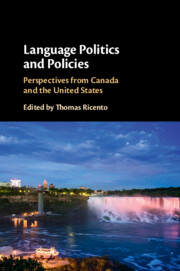Book contents
- Language Politics and Policies
- Language Politics and Policies
- Copyright page
- Dedication
- Contents
- Figures
- Tables
- Contributors
- Preface
- Contributor Personal Statements
- Introduction
- Part I Theoretical Orientations
- Part II The United States Context
- Part III The Canadian Context
- 11 Heritage Language Education Policies and the Regulation of Racial and Linguistic Difference in Ontario
- 12 A Foucauldian Approach to Language Policy in Canada
- 13 Promises, Acts, and Action
- 14 Language, Land, and Stewardship
- 15 A Land of Immigration and Official French–English Bilingualism
- 16 Ethnocultural and Linguistic Diversity
- Index
- References
16 - Ethnocultural and Linguistic Diversity
New Challenges to Canada’s Language Regime
from Part III - The Canadian Context
Published online by Cambridge University Press: 18 July 2019
- Language Politics and Policies
- Language Politics and Policies
- Copyright page
- Dedication
- Contents
- Figures
- Tables
- Contributors
- Preface
- Contributor Personal Statements
- Introduction
- Part I Theoretical Orientations
- Part II The United States Context
- Part III The Canadian Context
- 11 Heritage Language Education Policies and the Regulation of Racial and Linguistic Difference in Ontario
- 12 A Foucauldian Approach to Language Policy in Canada
- 13 Promises, Acts, and Action
- 14 Language, Land, and Stewardship
- 15 A Land of Immigration and Official French–English Bilingualism
- 16 Ethnocultural and Linguistic Diversity
- Index
- References
Summary
The chapter explores the relationship between official and “non-official” languages in Canada by taking as its starting point two Statistics Canada reports on ethnocultural and linguistic diversity released in 2017. Its goal is to examine how demographic trends, combined with recent debates and policy initiatives, are going to impact Canada’s language regime. The first section discusses international immigration. The second section focuses on Toronto, Montréal, Vancouver, and Ottawa. The third section reflects on how Canada’s language regime will respond to the challenges raised by the projected expansion of linguistic diversity in the population. The chapter concludes that, while Canada’s language regime shifted from Anglo-conformity to equality between English and French starting in the late 1960s, the projected increase in ethnocultural and linguistic diversity cannot render invisible the persistent pull of English, which could lend support to old Anglo-conformist attitudes and tendencies around language policy and planning in the country as a whole.
Keywords
- Type
- Chapter
- Information
- Language Politics and PoliciesPerspectives from Canada and the United States, pp. 298 - 315Publisher: Cambridge University PressPrint publication year: 2019
References
- 2
- Cited by



